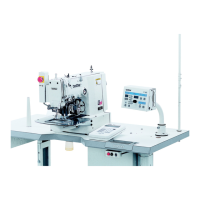5. USING THE OPERATION PANEL
19
KE-436C
5-2. Using the floppy disk
Compatible types of floppy disk
Data type No. of stitches programmed Data resolution Disk Format Write enabled
BAS-300E data
BAS-300F series
KE-436B,436C
20,000 stitches per pattern
100 pattern Up to a maxi-
mum of 360,000 stitches
0.05 mm/pulse Yes
Tajima embroidery data 50,000 stitches per pattern 0.1 mm/pulse
2HD 1.44 MB
No
Old BAS-300A data
4,000 stitches per pattern
10 patterns
Up to a maximum of
40,000 stitches
0.1 mm/pulse Yes
Old BAS-300 data
2,000 stitches per pattern
10 patterns
Up to a maximum of
20,000 stitches
0.2 mm/pulse
2DD
Automatically
formatted
No
• BAS-300E data can be used when sewing with the KE-436C, but the data resolution will be limited to 0.1 mm per pulse.
• The above four types of data can all be read, but when writing to disk, all data is automatically converted to BAS-300E data
when writing to 2HD disks and BAS-300A data when writing to 2DD disks.
• When using a 2HD disk, use a disk which has been pre-formatted as a 1.44 MB disk. (The programmer can be used to
format these disks. Refer to the programmer instruction manual for details.)
• TFD embroidery data can be embroidered after it has been converted by the programmer to BAS-300E data.
• Restrictions when using 2DD floppy disks and KE-436C data
In order to maintain compatibility with the old BAS-300A data, the following restrictions have been placed on the use of the
new functions which have been added to the E series.
Restricted function A series (2DD) E, F series (2HD) KE-436B, 436C (2HD) Applicable command
Resolution 0.1 mm/pulse 0.05 mm/pulse 0.1 mm/pulse
Low-speed conversion
2 types
(400 and 1,200 revolutions)
4 types (400, 600, 800
and 1,200 revolutions)
4 types (400, 600, 800
and 1,200 revolutions)
[668] L
[669] L
Split function during
embroidering
Not available Available Available
[220] L
[230] L
Needle down stop
for split
Not available Available Available
[221] L
[231] L
Expansion option output Not available Available Not available

